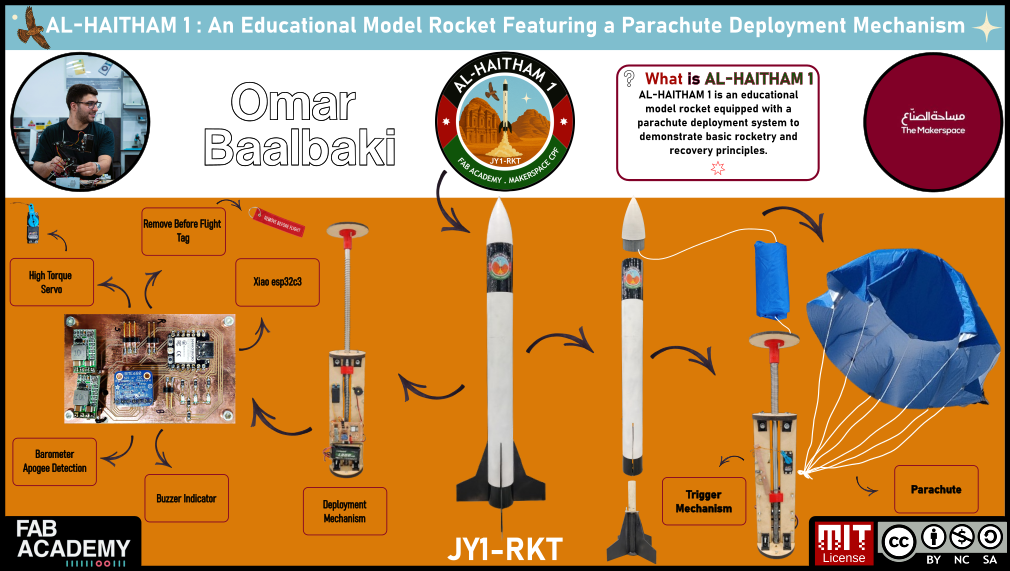Invention, intellectual property, and income
Summary
My journey through Fab Academy 2025 has been nothing short of transformative. From the first week, I was immersed in hands-on digital fabrication, electronics, and innovation at a level I had never experienced before. Each assignment challenged me to not only learn new technical skills but also to think critically, creatively, and independently. Whether it was designing PCBs, programming microcontrollers, building machines, or launching a final project that reflects my passion, every step contributed to a deeper understanding of how ideas turn into functional realities. Being surrounded by a global community of makers and innovators inspired me to push beyond my limits. Fab Academy didn’t just teach me how to make (almost) anything — it reshaped how I see engineering, problem-solving, and my role in the future of technology.
Work Process Detail
✅ Who is your project for?
This project is designed for educational and research purposes. It targets:
- STEM students interested in aerospace, rocketry, and electronics
- Makerspaces and Fab Labs aiming to develop hands-on space-related training tools
- Universities or schools that want to introduce students to real-world physics, flight mechanics, and telemetry
- Defense R&D institutions exploring small-scale prototyping of launch systems
💰 How is it funded?
The project is currently funded by:
- A scholarship from the Crown Prince Foundation (CPF) through Fab Academy Jordan (Maker Space)
📈 Is there a business plan?
At this stage, there is no formal business plan, but there is potential for:
- Creating a kit version of the rocket for educational institutions
- Offering workshops or training programs around rocketry design and simulation
- Collaborating with R&D labs or academic organizations that want to adapt or expand the system
🧩 How would you fund scaling up?
Scaling could be funded through:
- Educational or research grants (e.g. space education, STEM funding)
- Collaborations with universities or local space agencies
- Crowdfunding for public versions or educational outreach kits
- Potential private investment if commercial interest in STEM kits develops
⚖️ Why did you choose / not choose a license?
I chose the MIT License because I wanted to make my project as accessible and open as possible. The goal of this rocket project is educational—to inspire learning about rocketry, aerodynamics, and embedded systems. By using the MIT License, I’m allowing anyone to freely use, modify, and distribute my work, whether for personal, academic, or even commercial use.
This license aligns with the spirit of Fab Academy and open-source collaboration, encouraging others to build upon my work without legal complexity. At the same time, it ensures that my authorship is preserved and that the project is shared “as is” without liability—striking a good balance between openness and protection:
© Omar Baalbaki 2025
Permission is hereby granted, free of charge, to any person obtaining a copy of this project and associated documentation files (the "PROJECT"), to deal in the Project without restriction, including without limitation the rights to use, copy, modify, merge, publish, distribute, sublicense, and/or sell copies of the Project, and to permit persons to whom the Project is furnished to do so, subject to the following conditions:
The above copyright notice and this permission notice shall be included in all copies or substantial portions of the Project.
THE PROJECT IS PROVIDED "AS IS", WITHOUT WARRANTY OF ANY KIND, EXPRESS OR IMPLIED, INCLUDING BUT NOT LIMITED TO THE WARRANTIES OF MERCHANTABILITY, FITNESS FOR A PARTICULAR PURPOSE AND NONINFRINGEMENT. IN NO EVENT SHALL THE AUTHORS OR COPYRIGHT HOLDERS BE LIABLE FOR ANY CLAIM, DAMAGES OR OTHER LIABILITY, WHETHER IN AN ACTION OF CONTRACT, TORT OR OTHERWISE, ARISING FROM, OUT OF OR IN CONNECTION WITH THE PROJECT OR THE USE OR OTHER DEALINGS IN THE PROJECT.
Summary Slide:

Video Clip:
Fab Academy Main Link:
Youtube Link (Backup):
